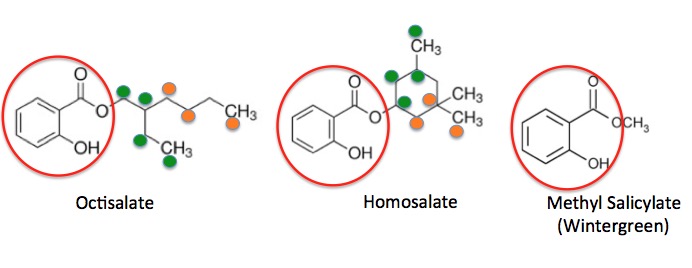A strange but interesting paper by scientists at The University of Wisconsin, which just appeared in PNAS, examines whether two similar sunscreen chemicals, homosalate and octisalate, could be a possible treatment for multiple sclerosis (MS). (See my colleague Julianna LeMieux's companion article "Sunscreen, MS And A Scientific Finding That Is Hard To Believe" about the biological activity of the chemicals.)

Sunscreen chemicals that may be useful for treating MS. Octisalate (left) and homosalate (right) may look structurally dissimilar but are anything but. The salicylate group (red circle) is found in both molecules. The green and orange circles show corresponding carbon atoms in both molecules. They are actually very similar. Both chemicals belong to the class of salicylate ester, the simplest being methyl salicylate (oil of wintergreen).
Yet, the EWG (Environmental Working Group) and it's even-dumber cosmetics watchdog offshoot Skin Deep (1) has a problem with these chemicals, which is hardly surprising; they rate the chemicals as "moderate hazards". And why might that be? You probably guessed already. The EWG calls them:

Shocking! Photo: Wikipedia
Homosalate is a potential endocrine disruptor and studies in cells suggest it may impact hormones. In addition to direct health concerns following homosalate exposure, the chemical may also enhance the absorption of pesticides in the body.Source: Campaign for Safe Cosmetics (2)
Talk about wishy-washy language! "May impact hormones?" "May also enhance the absorption of pesticides in the body?" That's not all that convincing, is it? Perhaps homosalate may also help the Knicks make the playoffs or change the tilt of the earth's axis (the latter is far more likely).
What is this statement based on? It turns out, not much. Let's take a look at the "evidence" of this endocrine disruption from the paper that these groups cite as proof that the various UV-filter (3) sunscreens will screw up your hormones. Try not to laugh.
The paper in question consists of two parts. One involves a series of in vitro (4) assays that measure whether the compounds in question induce estrogenic activity in isolated estrogen receptors. Six of six chemicals did so. The second part was designed to see if this translated into real-life estrogenic activity in zebrafish, which were genetically modified to contain a gene that makes it possible to measure whether the compounds affect the fish. None of the six compounds did anything.
In this transgenic zebrafish assay none of the compounds showed estrogenic activity.Source: Arch Toxicol. 2002 Jun;76(5-6):257-61
Well, THAT'S sure good evidence, right? Endocrine disruptors that don't disrupt anything.
 |
| Photo: Jan Fennell the Dog Listener |
Nice. But hardly unique. This is the kind of junk science that groups like EWG routinely use to scare people, and this is a great opportunity to point out how it's done. Pretty sleazy, no? It should make you wonder how many claims don't stand up when a light is shined upon them.
Sorry, dudes, You're busted. Lights out.
Notes:
(1) This has always puzzled me. The human physiological response (if any) elicited by trace amounts of various chemicals is a medical issue, assuming that it is an issue at all. Please tell me how this is an environmental issue. Hint: it's not. So, why are environmental groups (EWG is not alone) with little or no expertise in medicine spending a whole lot of time writing about this? Why not neurosurgery or bunions? Makes no sense. Unless they have other reasons for doing this. I won't $peculate about this.
(2) The Campaign for Safe Cosmetics is an umbrella group, which consists of EWG and other screwball organizations. I am unaware of a "Campaign for Dangerous Cosmetics."
(3) There are two basic ways that sunscreens protect you. Some contain zinc or titanium oxides which act like face paint - physically blocking the UV radiation. The other kind are a group of chemicals which have specific properties that enable them to absorb UV radiation and convert it to heat. You don't want to know exactly how this works. Often both types are used together.
(4) In vitro means "outside the body." This broad term encompasses "test tube" test (which are run in small glass wells, not test tubes). These assays include isolated enzymes and receptors, and cell-based assays, in which given activities of compounds are measured in cultured cells. Cell-based assays are a better representation of what may occur in vivo (in a living organism.)
No comments:
Post a Comment